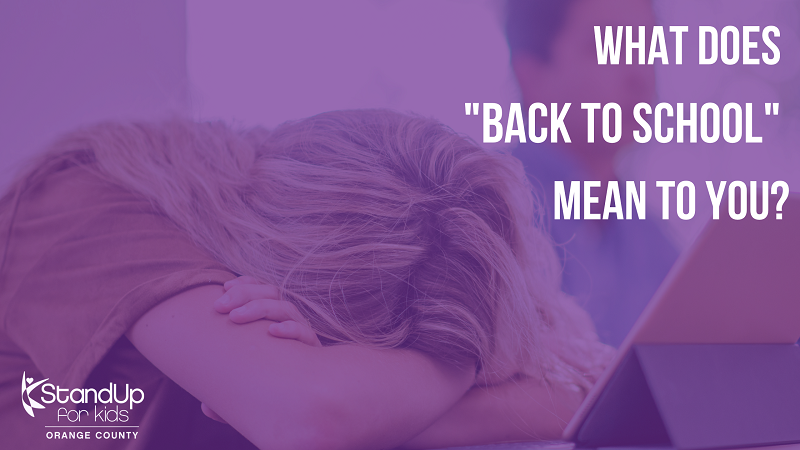StandUp for Kids – Orange County

As we get closer to the end of summer, the air is filled with excitement from the changing season, and the stores are filled with people as everyone rushes to prepare for the new school year. Suppose you remember those times in your young life. In that case, you might remember many emotions about going back to school, like thinking about seeing friends you didn’t see all summer or being in a new grade, or possibly even a new school.
You might also remember fears or worries, like: Will I like my teachers this year? Will my clothes be cool enough? Will I find a ride to school every day? Will I have a safe place to study after school? Will I find a bed every night?
Some may read those last few questions and wonder why a child returning to school would worry about such things. Still, the truth is that for certain students, those previous questions are often the first things on their minds when going back to school.
These questions represent real life for the almost 4.2 million children between 12-17 years old in the U.S. who experience homelessness to various degrees each year. Although there is no single reason that young people experience homelessness, there are many reasons why going back to school can be stressful for youths who don’t have a consistent and safe place to live.
Children who experience homelessness don’t have access to the same stability that every child needs to succeed in school. Children with a consistent home have access to many things that help them manage the everyday challenges of being a kid and a student. For example, a safe home provides a place to study outside of school, a comfortable bed every night, and the possibility of a good night’s sleep. A lack of proper sleep affects a child’s ability to learn and threatens their social and emotional development.
According to research done by the National Sleep Foundation, lack of sleep or consistent sleep deprivation can affect a person’s ability to stay focused and attentive, impair memory and learning, and reduce creativity. It also slows reaction times, impacting mental and physical tasks and significantly impacting mood, depression, anxiety, and aggression.
Another back-to-school concern for children experiencing homelessness is being absent. Chronic absenteeism is defined by the California Department of Education (CDE) as a student who is absent 10 percent or more school days during a single school year. The CDE reports that for the 2020-2021 school year, children experiencing homelessness make up almost 30% of chronically absent students.
Often, children experiencing homelessness are absent because they don’t have transportation to and from school. Over time, absences will make it difficult for a child to complete their schoolwork and keep up with their classes and classmates, possibly falling behind one grade or more. Falling behind can lead to dropping out of school altogether as it becomes too challenging to catch up or keep up with their classmates.
Getting to graduation can also be a unique challenge for the children faced with housing instability like homelessness. Like most children, students experiencing homelessness often desire to go to school, learn, graduate, and attend college. If a youth experiencing homelessness does graduate from high school due to factors like keeping up with schoolwork and absenteeism, the California Department of Education estimates they are 30% less prepared for college curriculum compared to their peers.
According to CDE data, the statewide average high school graduation rate for the 2020-2021 academic year is 83.6%. When the CDE compared that to high school students who experience homelessness, that rate drops to 67.8% – this is one of the lowest rates of any group of youths in the United States. The CDE also found that the percentage of high school-aged children who drop out of school before graduation is more than double that of students who do not experience homelessness (8.7% vs. 18.9%).
As youth experiencing homelessness reach the end of their high school education, those who don’t get the chance to graduate with their diplomas are forced into the world without a foundation to build their lives on. Without a high school diploma or equivalent, they are less likely to find a job, a safe place to live and may struggle to support themselves financially. This may set youths on a path of continued struggle and instability throughout their adult lives.
Resources for students experiencing homelessness can seem limited. At StandUp for Kids, we offer mentoring, advocacy, housing assistance, basic needs, and school supplies for our youth facing the challenges of homelessness or housing insecurity. This year, we even get to hand out brand-new Chromebooks to all our students, thanks to a generous donation from NetworkZen Foundation!
As we get back into the school year routine, it’s essential to remember what back to school means for children who don’t have access to the type of housing they need. Seemingly simple things like getting school supplies, having reliable transportation every day, and hot meals can quickly become problems that take more of a child’s attention away from their schoolwork.
Ending the cycle of youth homelessness starts with preventative measures like providing youth with the educational and social tools they will need to thrive in the world. The best way to support the fight to end youth homelessness is to support advocacy groups by volunteering, donating, or helping us spread the word by sharing this blog post!

